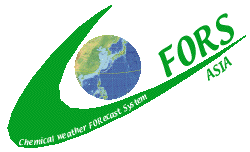



Outline of RIAM-
CFORS (Chemical weather FORecasting System) Version 1.5I.Uno , K. Ishihara, S. Satake, Zifa Wang, G.R. Carmichael and D.G. Streets
Research Institute for Applied Mechanics, Kyushu Univ. Japan
Center of Global and Regional Environmental Research, Univ. Iowa, U.S.A.
Version 1.5 (March 11, 2001)
We are developing and applying an operational Chemical weather FORecasting System (RIAM-CFORS) based on 3D on-line regional scale chemical transport model fully coupled with RAMS (Regional Atmospheric Modeling System). This system consists of several important components;
One of the main purposes of this system is to understand the regional transboundary pollution and to schedule/design the operational field monitoring campaign during the TRACE-P (TRAnsport and Chemical Evolution over the Pacific) and ACE-Asia (Aerosol Characterization Experiment - Asia) intensive observations. We will try to keep running this system until the end of April 2001. Results of daily operational foreasting will be posted around 0:00Z (9:00JST).
Please note that this site is presented as is and no guarantee is made as to the timeliness or accuracy of the forecasting data. We reserve the right to take off-line this site at any time for any reason without warning.CFORS-RAMS driver:
The parallel version of the RAMS(version 4.3.0) has been used to simulate the regional scale 3-D meteorological fields with
Beowulf type Linux cluster (17 nodes). The simulation domain adopted is centered at 25N 115E. The horizontal grid consists of 100 by 90 grid points, with a resolution of 80 km. In the vertical the domain is divided into 23 layers (top level is 20km).CFORS-MIRACL Chemical Transport driver
A tracer model is fully coupled with RAMS, and this is a unique approach because the regional meteorological conditions such as precipitation, cloud microphysics, diurnal cycle of boundary-layer turbulence play significant role in the wet deposition and vertical diffusion of tracers. The on-line tracer model runs with same time step as the RAMS, so that all the on-line meteorological information such as 3-D wind field, boundary-layer turbulence, surface fluxes and precipitation amount is directly used by the tracer model at every time step. Present CFORS system includes the following chemical transport species;
* indicates that concentration of this species decay as a first order reaction rate.
CFORS: Operational Time Charts:
Operational global forecast data set access to NCEP (National Center for Environmental Prediction) AVN data set and Japan Meteorological Agency (JMA) DDB data set are operationally ftped. See CFORS
daily timing cycle chart.CFORS:Post-processing options
CFORS web manager supports the necessary post processing of the forecasting results both meteorological and chemical components. The 2/3D user friendly interface is prepared for easy use of this system.
Acknowldements
This work is supported by Research and Deveopment Applying Advanced Computational Science and Technology of Japan Science and Technology Corporation (ACT-JST). Work by US scientists is supported by NSF and NASA.
Thanks to the significant helps from Mr. Jim Yienger, Mr. Sarath Guttikunda, Dr. Mahesh Phadnis, Dr. Atusi Numaguti, Dr. Toru Nozawa, Mr. Toshihiko Takemura, Prof. Mitsu Uematsu, Mr. Hiroki Yoshii and Dr. Seita Emori.
Å@
Corresponding persons information
Itsushi Uno, Prof. and Koji Ishihara, Mr.
Research Institute for Applied Mechanics, Kyushu Univ., Japan
e-mail: iuno@riam.kyushu-u.ac.jp